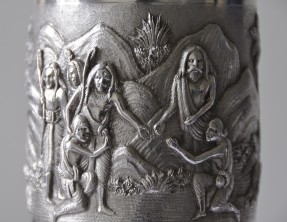In 1960 Sadequain journeyed to Paris at the invitation of the French Committee of the International Association of Plastic Arts. This period of his career is considered by many to have been the zenith of his artistic output, and it was whilst in Paris that Sadequain completed one of his most important commissions; providing the illustrations for a newly published edition of Albert Camus’ seminal novel L’Etranger.
Albert Camus was a French author, journalist and philosopher who was awarded the Nobel prize for literature in 1957. Originally published in 1942, L’Etranger (The Outsider), was his first novel and opens with the famous line; “Aujourd’hui, maman est morte. Ou peut-être hier, je ne sais pas“, (Mother died today. Or maybe yesterday, I don’t know). It is considered a classic of French literature, and in 1999 was voted number 1 in Le Mond’s list of the 100 greatest books of the 20th century.
In 1964, four years after Camus’ untimely death, Sadequain was commissioned to produce a series of lithographs for the special edition of the book. It was published in October 1966 by ‘Les Bibliophiles de l’Automobile-club de France’, a society that was founded by the early motoring pioneer the Marquise de Dion in 1895, and which began publishing artist’s books in 1925. (Source: Koninklijke Bibliotheek). The book was published in a limited edition of 150 copies, with 120 copies dedicated to members. Sadequain created 22 colour prints, and a number of monochrome prints to illustrate key scenes in the book, which deals with themes such as the irrationality of the universe and importance of the physical world.
At the time it was an unprecedented move by the publishers to engage Sadequain’s services. When one considers how many artists were working in Paris in the 1960s, it shows how highly regarded he was in Parisian artistic society at the time.
The ‘L’Etranger‘ illustrations represent an extremely important body of work, but are only a small part of the rich output produced by Sadequain whilst in Paris, which will be discussed in greater detail here in due course.



















You must be logged in to post a comment.